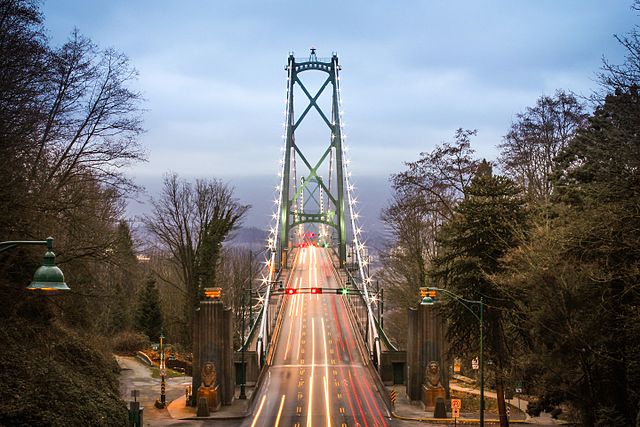https://www.clarkcountytoday.com/opinion/opinion-putting-interstate-bridge-misconceptions-to-rest
This is a river crossing that should have been upgraded decades ago. Montreal also had to wait several decades to get their new and improved bridge.
https://www.interstatebridge.org , https://www.interstatebridge.org/about
At least this has been a 6 lane crossing for several decades. In Vancouver, Canada, or V-BC, everything is still funneled into an inadequate 3 lane Lion Bridge for the past several decades. https://www.youtube.com/watch?v=3jeNjKZExfE , https://www.youtube.com/c/IBRProgram/videos
https://www.cityofvancouver.us/cmo/page/interstate-bridge-replacement-program It would be total chaos if Portland and Vancouver, WA were forced to just have a 3 lane crossing like V,BC still has. So while the I-5 Bridge that's a few miles north of downtown Portland has 6 lanes, the Lion Bridge north of downtown Vancouver, BC is only 3 lanes.
https://en.wikipedia.org/wiki/Interstate_Bridge#First_bridge At least when the first bridge opened, it was set up for trams or streetcars, as well as being a highway bridge. Unfortunately, the rail mode of the bridge only went from 1917 to 1940.
https://en.wikipedia.org/wiki/Interstate_Bridge#Upgrades Then by the 1950s, there was no reason to put in a parallel rail section next to the new bridge.
https://en.wikipedia.org/wiki/Interstate_Bridge#Interstate_Bridge_Replacement_Program_(2019-present) Fortunately, the new Portland & Vancouver, USA bridge, will have a passenger rail component to it. This has already worked out very well on the I-90 Bridge in Seattle & for a new bridge in Montreal.
https://www.google.com/maps/place/Montreal,+QC/@
https://en.wikipedia.org/wiki/Champlain_Bridge_(Montreal,_2019-present) This was possible for Montreal, because that city doesn't have a multi-generational thwarting power structure or Gordian_Knot like laws to prevent it. Where as VBC does have such thwarting laws that goes right back to the early decades of the city.
https://www.oregonlive.com/commuting/2019/09/oregon-and-washington-well-start-building-a-new-interstate-bridge-by-2025.html Inspite of it being a very slowgoing process, Portland & Vancouver, WA will get their version of what Montreal already has. https://en.wikipedia.org/wiki/Columbia_River_Crossing#Interstate_Bridge_Replacement_Program
Meanwhile, Vancouver, BC will still be stuck with a 3 lane Lion bridge that has no provision for bus lanes & especially no rail transit. If it could have had at least 4 lanes like the St._Johns_Bridge in Portland, then it would have been easier to have a bus & HOV lane each way. https://historicbridges.org/bridges/browser/?bridgebrowser=oregon/stjohnsbridge Any major crossing in an urban area should have at least 4, if not 6 or 8 lanes. Of course some cities even have larger capacity crossings.
https://forbiddenvancouver.ca/blog/lions-gate-bridge-lions-guard There was a time in BC that if you could have 2 waggon roads next to each other, that was a big deal. https://www.insidevancouver.ca/2012/06/12/inside-vancouvers-hidden-past-the-secret-history-of-the-lions-gate-bridge So instead of the Lion Bridge having 6 lanes or at least 4, it was to only have 2 (waggon) lanes. Fortunately, there was just enough extra space to eventually fit in a 3rd lane. However, with no provision for an extra deck, any bus & HOV lanes or rail transit there, just isn't possible. https://placesthatmatter.ca/location/lions-gate-bridge
https://dailyhive.com/vancouver/lions-gate-bridge-close-overnight By now, most real cities would have twinned that crossing, or bypassed it with a 6 to 8 lane tunnel. But this is backwater BC, where you are lucky to even have just a few waggon roads at key crossing points.
https://structurae.net/en/structures/lions-gate-bridge Of course even when the bridge was rebuilt, no additional deck for trains or buses was put in. Most likely, the towers & cables would have had to be substantially reinforced to support an extra deck, so for the sake of aesthetics, the bridge retained its overall slim appearance as a 3 lane choke point or bottle neck.
Any future Inlet rail transit lines will likely be situated much closer towards the Iron Bridge.
https://dailyhive.com/vancouver/north-shore-rapid-transit-bus-rapid-transit-park-royal-metrotown-brt
It's as if a monstrous force has been growing since BC colonial times. This force is like a multigenerational thwarting mindset, generated by all the various interest groups for well over a century. Fortunately, this thwarting collective force hasn't been able to thwart Oregon, Washington State and Alberta to the same extent. All one has to do is look at how much larger the infrastructure is allowed in many other places.
When done correctly, bridges and tunnels can be efficient high volume conduits. Especially by providing various modes of transportation.
https://thedigitallabyrinth.blogspot.com/search?q=highways
https://embracesomeplace.com/living-seattle-portland
https://thedigitallabyrinth.blogspot.com/search?q=Montreal

